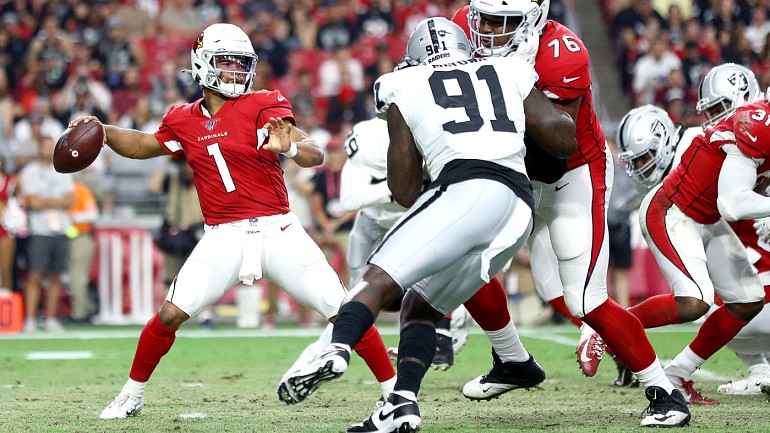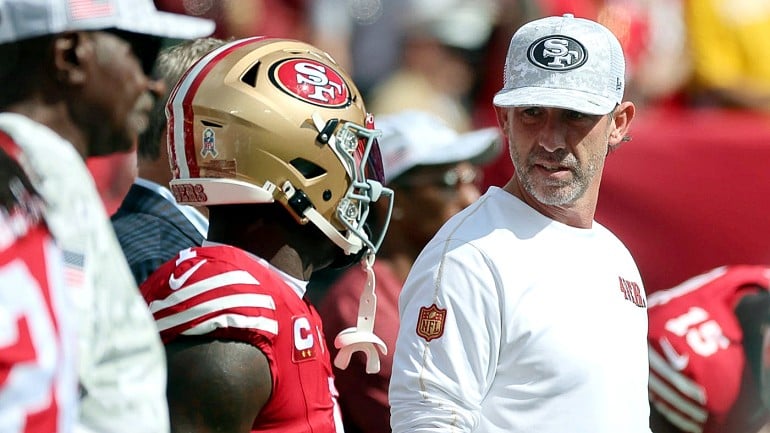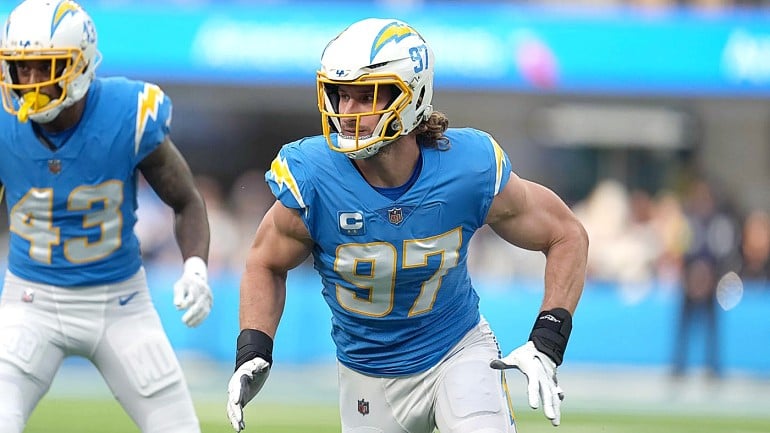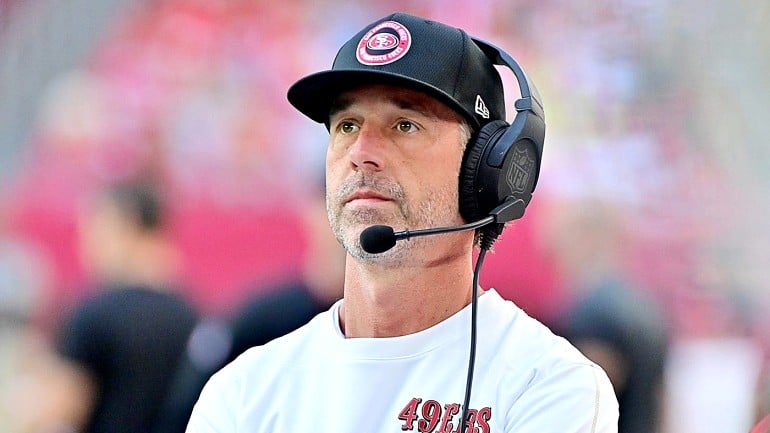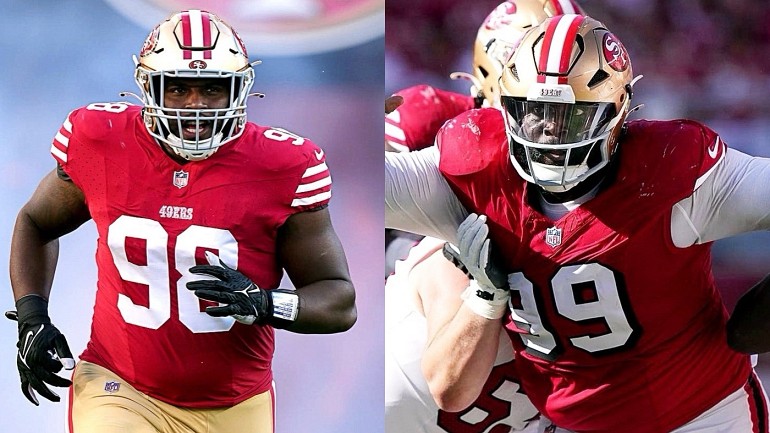This is a two part series exploring the inner workings of the air raid offense under Arizona Cardinals head coach Kliff Kingsbury, its history, and the basic running and passing concepts we can expect to see against the 49ers defense.
On Tuesday January 8th, just a little over a week after the 2018 regular season ended, the Arizona Cardinals shocked the football world by hiring Kliff Kingsbury, as first reported by Sande Charles, Cardinals Fan Girl of the FanGirl Sports Network the previous night. The Arizona Cardinals official media site reported the signing the next day as Kingsbury was interviewed in the morning and signed his contract by the afternoon.
Kingsbury was previously the head coach at Texas Tech, where he coached Patrick Mahomes, and finished with a career head coaching record of 35-40. His Red Raiders finished above .500 just twice in six seasons under his leadership. Still, he was a very sought after coach after being fired by Texas Tech last November. He eventually took the offensive coordinator job with the USC Trojans for about a week before interviewing with several NFL teams including the Rams and Jets.
Of Kingsbury, Rams head coach Sean McVay said "I think he's been a very good head coach. I think he's a great communicator, he's got a good juice and enthusiasm. He has a nice presence about him. You feel confident the players will respond to him. The production of his offenses, he is a creative mind."
Despite the record, it's easy to see why the Cardinals took a chance on a young head coach. The 49ers and Rams both did it, and Kyle Shanahan and Sean McVay are considered some of the best young play callers in all of football, both running a West Coast-style offense that is the product of both coaches' upbringings. The Cardinals are looking to capture that same magic with Kingsbury and the air raid offense, a system that has been ingrained in him since his days as the quarterback under Mike Leach.
The Air Raid Offense: a very brief history
Before we dive into the air raid offense concepts, we begin with a brief origin story. When fans come across the Air Raid offense, they typically think of the eccentric Mike Leach, current head coach of the Washington State Cougars and former head coach of the Texas Tech Red Raiders, who revolutionized the way the Air Raid is executed in the 2000s. But the Air Raid did not originate with Leach. It can be traced back to LaVell Edwards, the infamous BYU head coach (for whom 49ers Hall of Fame quarterback Steve Young played), and Edwards' offensive coordinator Doug Scovill.
Scovill spent time in the NFL (6 seasons with the 49ers in the 1970s) when a man by the name of Sid Gillman was implementing these offensive concepts at various stops in the league. Scovill brought the ideas back with him to BYU where he and Edwards simplified the concepts for college kids.
However, the basic premise of the Gillman-style offense was that it should use the entire field to its advantage, every area at every level, through the use of horizontal and vertical stretch passing concepts. The idea was that the defense cannot be everywhere, even with nine dropping into coverage. There would always be an open zone for a receiver to work to and the quarterback to exploit as a result. Against man coverage, the receivers would have built-in checks and reads that enabled them to switch their routes on the fly based on the coverage.
The BYU offenses were still constructed around a predominantly two-running back formation out of split backs and with the quarterback under center. Around this time, Hal Mumme and others would make regular journeys to BYU to study and learn the offense that Edwards was running at the collegiate level. Mumme was a rather unsuccessful high school coach at the time, someone who S.C. Gwynne dubbed "one of those career losers, of whom there are thousands in the coaching world, well-meaning, somewhat sad men with a bit of wistfulness in their voices who lack whatever it is that makes teams win."
After a short stint coaching in high school, Mumme took the head coaching job at Iowa Wesleyan, a small division three school in the NCAA where he hired Mike Leach to be his offensive coordinator. It was here where they really perfected the Air Raid offense, introducing more shotgun spread formations and cutting down on the running game concepts because all they really wanted to do was throw the ball down field.
In their first year at Iowa Wesleyan, Mumme and Leach coached a previously 0-10 team to a 7-4 record. The next season they finished 7-5, and in their final season finished 10-2. The duo then left for Valdosta State where they won 40 games in 5 seasons. The duo would coach at Kentucky before Leach eventually jumped ship to coach under Bob Stoops at the University of Oklahoma in 1999. Leach would eventually take the head coaching job at Texas Tech in 2000 after one season with the Sooners.
Air Raid player connection to the NFL
It was here were Leach really grew the Air Raid. In his first season, Leach coached quarterback Kliff Kingsbury to a 3400 passing yard season on 585 attempts. Kingsbury threw for 5012 yards on 712 passing attempts in his senior season to go along with 45 touchdowns. Other Air Raid quarterbacks have had similar success. Case Keenum holds the NCAA record for passing yards with over 19,000 to go along with his NCAA record for most passing touchdowns with 155.
Others on the career passing records list who played in an Air Raid system include Graham Harrell who ranks fourth in career passing yards and third in career touchdown passes, Baker Mayfield (7th in career passing yards, 4th in career touchdown passes), Luke Falk (8th in career passing yards, 10th in career touchdowns), and of course Patrick Mahomes, who, in his final season at Texas Tech, threw for over 5000 yards and 41 touchdowns. Mahomes also threw 50 touchdowns last season to go along with 5000+ passing yards and won the Most Valuable Player award for the 2018 season.
At least one Air Raid quarterback, Nick Foles, recently won a Super Bowl with the Philadelphia Eagles. Foles played in the Air Raid under Mike Stoops at the University of Arizona and has excelled with spread offense/Air Raid concepts at the NFL level.
There is no shortage of influence in the NFL right now of Air Raid coaches and non-quarterback players (former Patriots receiver and now 49ers assistant Wes Welker, former 49ers receiver Michael Crabtree among them, who recently just signed with Kingsbury and the Cardinals). Speaking to the New York Times, Leach recently said "The last several Super Bowls, those were Air Raid teams. They didn't necessarily call themselves that, but they ran a ton of Air Raid concepts." Mumme added in the same New York Times article: "I think the Patriots have been doing a good bit of it for a long time — probably about 10 years. From the time they got Wes Welker I think they've been doing very similar things."
While the passing game is king for the Air Raid offense, as evidenced by the amount of quarterbacks and receivers the system has produced, a good running game behind it can take advantage of the defense's tendency to protect against the pass. As offenses evolve, though, the running game can be used as an extension of the passing game where they get the offensive linemen involved in selling the run game blocks while the quarterback executes a play fake and throws deep (as we shall see later in some concepts in part 2).
The Air Raid Offense: running game
So what are the run game concepts? There are a few in the Air Raid at the collegiate level, but in the NFL, Kingsbury will need to adapt his offense to meet the demands of the talent on his offense and against the defenses they'll face this season. For that to happen, the Cardinals will have to install an offense similar to what Murray ran at Oklahoma, which has a much more diverse running game than the offense Kingsbury or Leach ran at Texas Tech. Indeed, Kingsbury has acknowledged this as well, telling NBC Sports Peter King that his offense will be "very similar" to the one Murray ran at Oklahoma under head coach Lincoln Riley.
To get a sense of what Kingsbury might run at the NFL level, we'll take a look at both the running game he installed at Texas Tech and the running game under Lincoln Riley that Murray executed at Oklahoma.
First, one thing that needs to be explained about the Air Raid offense in general, and running game in particular, is that the linemen take larger than normal line splits that give the offense several advantages: 1) open throwing lanes for the quarterback, 2) force pass rushers to come from farther away, and 3) to get only one or two key blocks to open a big running lane since the defense is spread out.
Maybe you can tell from this but Cardinals OL will have some wide splits this season pic.twitter.com/48j5JNJdvO
— Kent Somers (@kentsomers) August 3, 2019
24 Lead

Lead is basic isolation blocking play where the line blocks the man in front of them or blocks down on the play side. The play was originally run out of a 2-back back field with the lead blocker being the second back.

The assignments above show the fullback leading up to the second level, but in a one-back personnel group, the play side lineman block down in order for the tackle to lead block up to the second level.
As the Air Raid became more of a spread attack, Texas Tech began running this out of a single back set and therefore having to use a pulling lineman akin to running power, which it essentially is. The line blocks down and the left tackle lead blocks through the point of attack for the running back who gains 12 on the run.
26 Power

Whereas "24 Lead" is designed to hit up the middle with the lead blocker, "26 power" is designed to press the edge with the pulling blocker acting as a lead block to the front side of the play.

The left guard in the diagram kicks out the end man on the line of scrimmage rather than leading through the hole up field.
In power, the offense creates an extra gap with the pulling blocker to the front side, giving them a man advantage and sealing off the backside with down blocks. Notice again the wide splits on the play side, and the tight splits on the back side. The back side splits are usually tighter in Texas Tech's offense to prevent back side penetration from disrupting the timing of the running game.
28 Stretch

"28 Stretch" is the outside zone, something 49ers fans should be familiar with. The stretch/outside zone seeks to move a defense laterally and pin it to the inside. To accomplish this, the linemen will use a blocking technique known as the "rip and run" to either pin defenders to the inside (rip) or, if they have not reached their defender by the third step, seek to run the defender to the sideline (run). At the snap, the telltale sign of an outside zone run is the kick step to the sideline the offensive line takes.

The running back has a three-cut responsibility dictated by the movement of the offensive line. This isn't so much a defined cutback, but rather a 1-cut and get up-field decision by the running back. The blocking and movement of the defense creates three reads for the running back: bounce, bang, bend. This is based on reading the two defenders on the end of the line of scrimmage to the play side. The landmark to make the read is the butt of the tight end.
In the Air Raid, the linemen take the wider splits, getting the defensive front to line up head up on the tackles rather than outside in an effort to cut down on the possible running lanes. The stretch doesn't have a defined running lane so if there is a wide defensive end, chances are the running back will just cut inside of that defender such as in the play above.
If the defenders to the play side seal off that edge with penetration to the outside gaps, the running back is free to cut back against the grain but must see that develop by the third step at least.
Inside zone
Whereas the outside zone is more of a lateral movement from the offensive line, the inside zone is the same blocking principles but done more vertically up field. The linemen try to push the defenders back rather than run them to the sideline or pin them inside. The inside zone is characterized by zone blocking where the linemen either block the man in front of them or if uncovered, block the man down from them in a double team before working up to the second level.
The Texas Tech linemen take the same wide splits on this inside zone. This allows the double team at the point of attack while the play side guard and tackle easily reach their defenders. The defense has to cover too much ground to get into its run fits and by the time it does, the blockers have plugged those fits as the back hits the hole.
Inside zone cap
On the inside zone cap, the "cap" refers to the extra blocker on the back side (usually a tight end) blocking the defensive end to his side, the C-gap defender. This allows the back to cut to the backside if there is nowhere to go on the front side of the play.
Counter
While we'll no doubt see the outside zone and inside zone runs feature prominently in Kingsbury's offense, it is also equally likely that we'll see the counter run and its various offshoots if we're to believe Kingsbury when he says his offense will resemble Oklahoma's.
According Noah Riley of Riley Kolste Football and author of Breaking Down the 2018 Oklahoma Offense, the Sooners base run was the counter run and "accounted for 47% of the Sooners rushing yards. If you treat every formation, motion, and tag as a different play, the Sooners ran over a hundred variations of counter." That's a pretty diverse running game!
Counter is a gap-scheme run that uses two lead blockers to lead for the running back on the play side. On the counter run, the linemen to the play-side block down on the defensive line to create a wall, while a combination of any two backside blockers pull to the play-side. The backside guard always pulls and is responsible for kicking out the play side contain player, while either the backside tackle, H-back, tight-end, or fullback will pull and then lead into the hole for the running back.
According to Riley, the Sooners ran counter 214 times for 1736 yards. The main variant of that was the GT counter (guard-tackle).
GT Counter
Here against UCLA, the Sooners are running GT counter to the weak side by pulling the guard and tackle from that side and creating the C-gap for the back to run through. However, the edge defender pinches the C-gap and forces the back outside but it goes for a decent gain anyway.
Another variation of the GT counter is the GT counter with a front side tight end (or 2).
This is a nicely designed run against teams that don't play both corners to the two-receiver side. According to Riley, Texas Tech's defense tended to play with a corner in the box on these nub formations. The only unblocked player was the safety to that side sitting at 15 yards.
GF Counter
Another variant of the counter run is the GF counter.
It's the same blocking principles up front with the pulling guard but instead of the tackle as the second puller, another running back or fullback becomes the other lead blocker. This play was usually run out of the pistol formation.
The addition of the fullback as a lead blocker can also create an element of misdirection as in the play above, where he starts on the front side of the play and flows toward the backside end similar to a sift block on the split zone before arcing back behind the guard to be the second blocker.
TF Counter
Yet still another variant is the TF counter with the tackle leading instead of the guard. Again out of pistol formation, quarterback Baker Mayfield takes the high snap and still manages to get it to his running back, who cuts through the TCU defense for a touchdown.
Counter read
The last variant, the counter read, is something we could see from Murray this season but it's unclear how much Kingsbury would want to risk running him. I suspect they'd only use it if they knew for sure it was going to net them a big gain.
On the counter read, the read is the same for the quarterback as it is on the zone read. Murray reads the unblocked defensive end to the right side of the offense. If the defender crashes the running back, he'll keep it. If the defender stays home on contain on the backside, he'll give to the running back. Here, the UCLA defender stays home so Murray gives to the running back, who picks up a decent gain.
In part two of this series, we'll take a look at a variety of the core passing concepts we're likely to see out of the Cardinals this season, some of which we've already seen in the preseason, albeit vanilla versions of them.
For further reading on the history and schematics of the Air Raid offense:
Books
S.C. Gwynne, The Perfect Pass: American Genius and the Reinvention of Football
Noah Riley, Breaking down the 2018 Oklahoma Offense
Articles
Cody Alexander, Desert Heat: The Air Raid Invades the NFL – Pt. 1 and Desert Heat: The Air Raid Invades the NFL – Pt. 2
Chris Brown, The Air Raid Offense: History, Evolution, Weirdness – From Mumme to Leach to Franklin to Holgorsen and Beyond
Chris Brown, Texas Tech run game cut-ups
Benjamin Hoffman, The Air Raid Offense Invades an N.F.L. That It Already Conquered
Michael Lewis, Coach Leach Goes Deep, Very Deep
Video
Oklahoma All-22 cut-ups courtesy of Noah Riley
